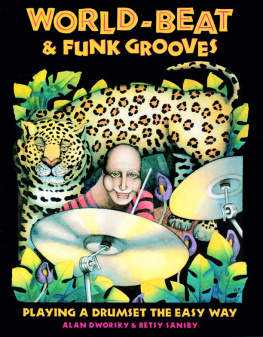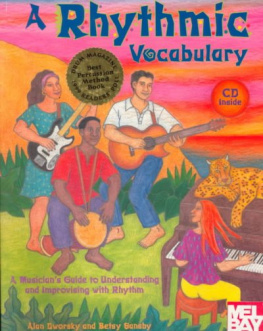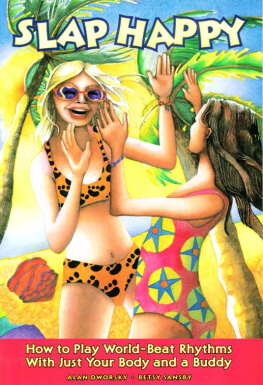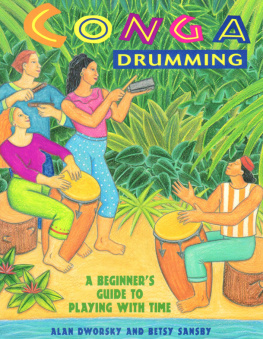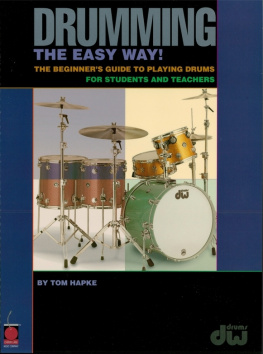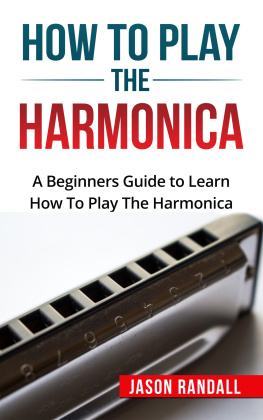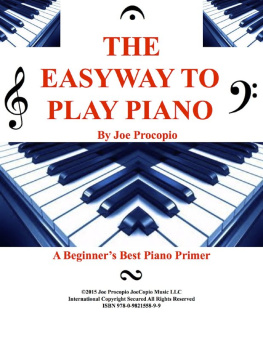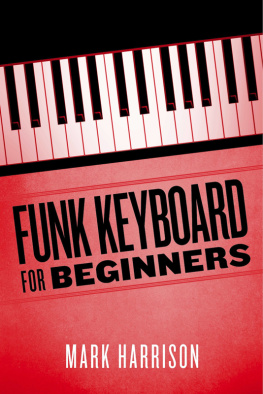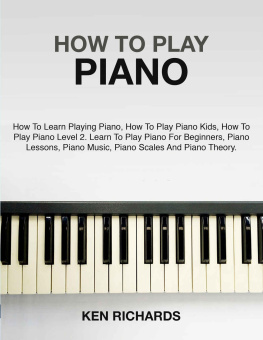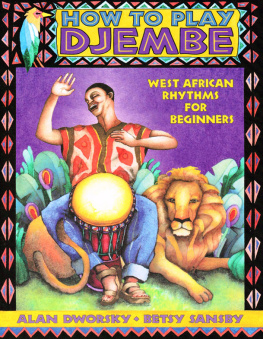
Important Notice
The print version of this book came with an audio CD containing recordings of cowbell and clave patterns that the drum patterns in the book are designed to be practiced with. The print version of this book also came with an audio CD containing recordings of all the drum patterns in the book. If you would like to order these CDs in physical form or as downloadable audio files, go to www.dancinghands.com.
At the end of this ebook, youll find information about other instructional books and videos available from Dancing Hands Music. These include the Gentle Djembe for Beginners video series, as well as the videos Bongo Grooves for Beginners and Cajon Grooves for Beginners.
World-Beat & Funk Grooves: Playing a Drumset the Easy Way
Copyright 1999 by Alan Dworsky and Betsy Sansby
Published by
Dancing Hands Music
4275 Churchill Circle
Minnetonka, MN 55345
800-898-8036 (phone or fax)
612-933-0781 (from outside the U.S.)
www.dancinghands.com
Cover art and illustrations by Toni Pawlowsky
Chapter 10 illustrations by Jay Kendall
Book design and production by MacLean & Tuminelly
Patterns CD editing and mastering by Wild Audio
Printed in the United States of America with soy ink on recycled, acid-free paper by Banta ISG (Viking Press)
All rights reserved. No part of this book may be used or reproduced by any means without permission.
ISBN: 0-9638801-3-6 ISBN OF EBOOK VERSION : 978-0-9857398-5-0
To George Marsh, author of Inner Drumming, with the hope that well get a chance to thank you in person someday.
We would like to express our gratitude to all our teachers, including Gordy Knudtson, Paul Lagos, Marc Anderson, and Lefty Medina. Thank you also to those who have taught us through their books and videos, including Gary Chaffee and David Locke. Were also indebted to the authors of the other sources listed at the back of this book and to all the unknown creators of the rhythms of the world.TABLE of
TABLE OF CONTENTS
CHAPTER
Who this book is for and how it works

A re you a beginner who wants to get right to the fun stuff? If youve got a drumset and you know how to make the basic strokes, youre ready to get started. This book uses an ingenious method that makes complex rhythms magically emerge out of simple sequences of body movements. Within days youll be playing world-beat and funk grooves that usually take months to master.
Our method is based on a style of playing called linear drumming. Linear simply means you only play one note at a time. Thats why its great for beginners. Instead of learning separate parts for your hands and feet and then layering one on top of the other, you only have to learn a single pattern that moves note by note from limb to limb. Its as easy as connecting the dots.
There are no boring exercises in this book, only great grooves.
Many are linear arrangements of traditional African and Afro- Cuban rhythms. Others are classic funk grooves, and some are patterns we created ourselves in either a funk or world-beat style. Each one is a pleasure to play.
The book is organized into twenty-three bite-sized lessons. Each lesson is based on a short sequence of hand and foot strokes we call a dance. Within the lessons, the patterns start simple and gradually get more complex. But youll hardly notice it, because we make sure you get the right-size steps, in the right order, at just the right time.
Weve made the charts as simple as possible so you can follow them even if youve never read music before. Weve also made them as big as possible so you can read them from a distance. And we dont just dump a pile of charts on you and leave. Well be with you every step of the way, anticipating your questions, pointing out whatever is most important, and explaining whatever we think will make your journey easier.
Weve done everything else we could to make this book as user- friendly as possible. Whenever we introduce a new Playing Principle or Practice Principle, we highlight it in the margin for easy reference. Whenever we introduce a new term, we print it in bold letters, define it on the spot, and toss it in the glossary at the back of the book. Weve even used a special binding that makes the book stay open and lie flat without the help of a shoe.
The book comes with two CDs. Each one serves a different purpose. The Patterns CD contains short samples of every pattern in the book, so you can hear how each one is supposed to sound. The Timelines CD functions like a practice partner. It contains reference rhythms (called timelines) for you to play along with, so youll get a taste of what its like to play in an African or Afro-Cuban ensemble.
We put the chapter called Working with the Timelines CD at the end of the book only because we dont know exactly when youll be ready for it. But we hope youll turn there as soon as possible. Remember when Dorothy enters the Land of Oz and the screen goes from black-and-white to technicolor? Thats what its like when you switch from playing alone to playing along with a timeline.
To help you learn how the patterns fit with the timelines, weve recorded each pattern on the Patterns CD along with the appropriate timeline. If you want to hear how a pattern sounds without the timeline, simply turn the balance on your stereo all the way to the right. If you want to hear how a pattern sounds with the timeline louder, simply turn the balance a little to the left.
World-Beat & Funk Grooves is a complete introductory course in linear drumming. Weve designed it so you can work through it all by yourself or with the help of a teacher. Our goal is to introduce you to some great rhythms while helping you get comfortable behind a drumset. Once you understand how our method works, youll be able to integrate linear drumming into other drumset styles, which is what most of todays best drummers are already doing.
But no matter where this book takes you in the future, its designed to be pure pleasure right now. So lets get started.
CHAPTER
How to read the charts
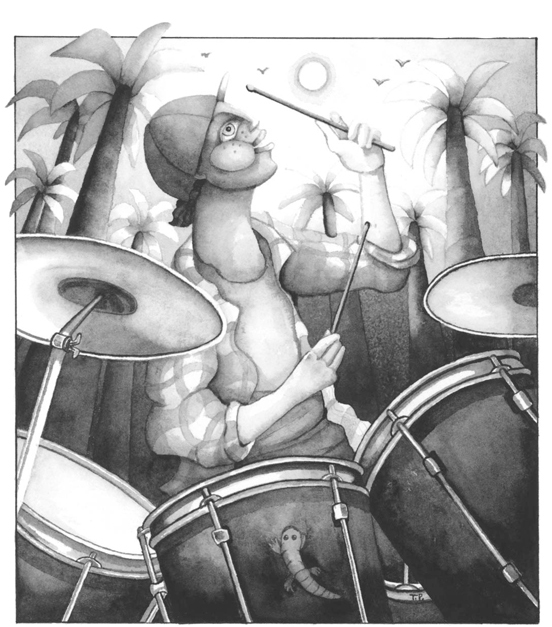
F or the charts in this book weve used whats called Swiss style notation instead of standard drumset notation. We like Swiss style because each limb gets its own row on the staff: right hand (RH) above the top line, left hand (LH) below the top line, right foot (RF) above the bottom line, and left foot (LF) below the bottom line. This allows you to tell at a glance which limb to use on a note and eliminates the need for extra Rs and Ls cluttering up the chart. It also creates a good visual representation of the flow of a pattern through the body.
Heres a typical chart:

The symbol used for each note tells you which instrument to play: snare drum, hi-hat, cowbell, etc. All the symbols used in this book are on the next page. Most of them are the same as the symbols used in standard drumset notation. If you dont already know them, dont bother memorizing them now. Youll pick them up easily as you work through the patterns.
At the top of each chart youll see a row of numbers that shows how were counting a pattern. Numbers in bold on the count row indicate the notes of the timelines youll eventually be playing along with on the CD. We explain more about the timelines in , which you can turn to any time youre ready.
Next page
